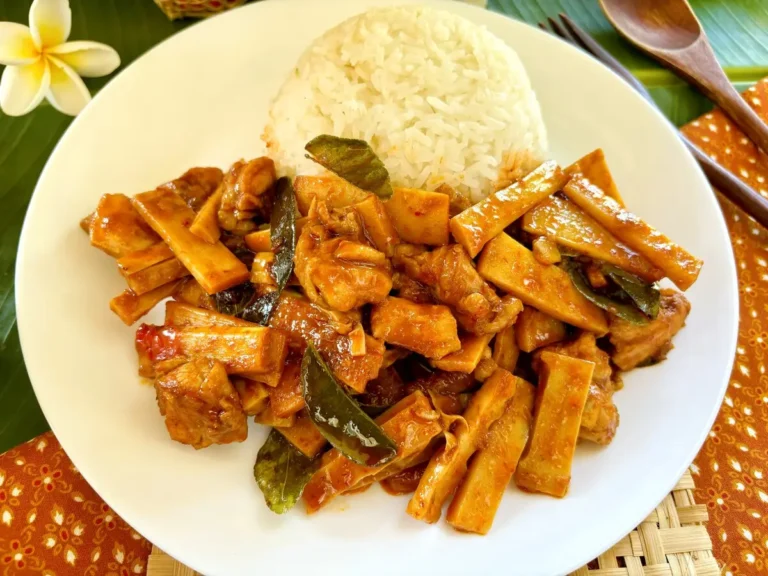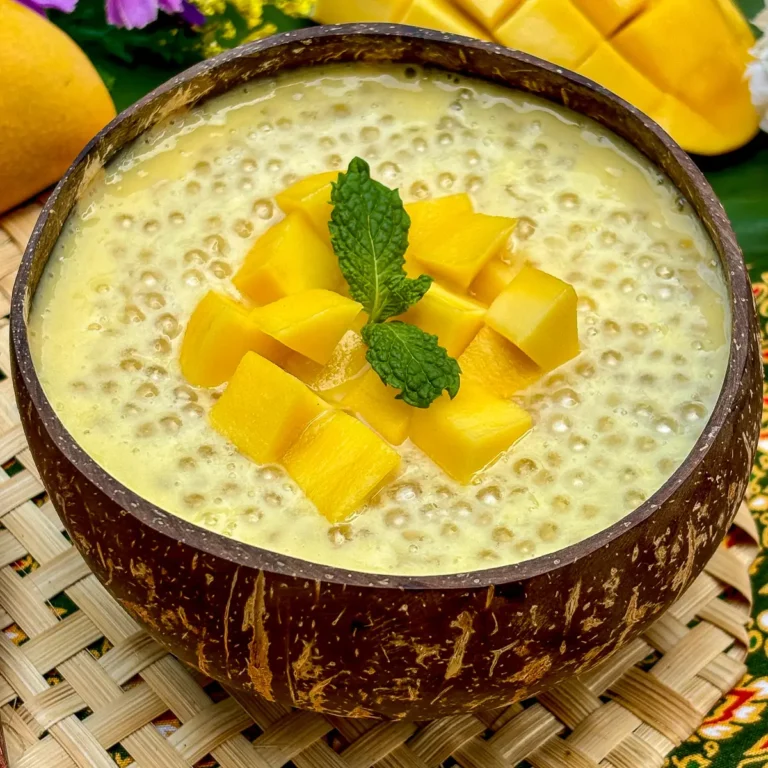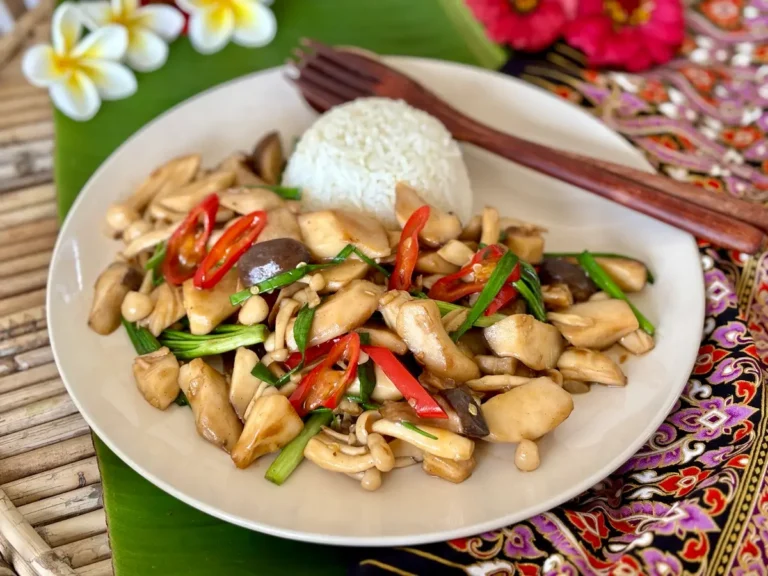Kua mee recipe featuring saucy Lao noodles with egg, shining with sticky caramelized sugar. Hands down one of THE BEST family favorites, perfect for parties, great for busy weeknights.
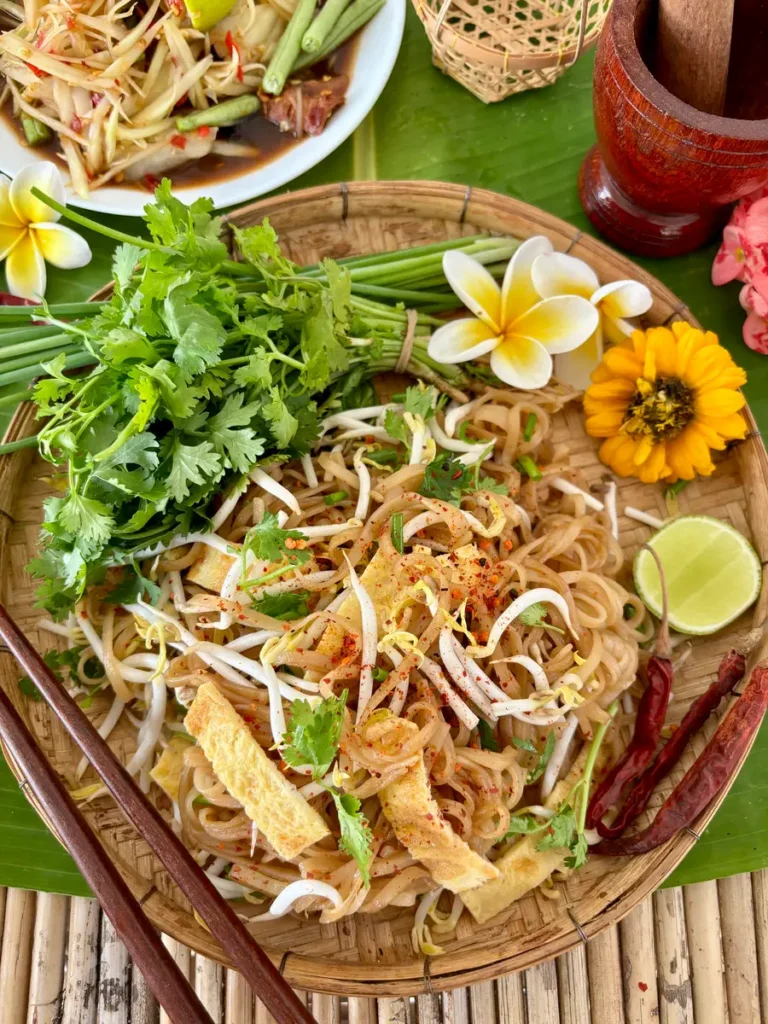
After making these pad Lao noodles, try some more Lao recipes like jeow bee, jeow bong, and khao poon.
What is kua mee
Kua mee is a signature Lao noodle dish with a savory and sweet flavor profile. Often made with rice noodles, this dish gets is unique sweetness from caramelizing sugar at the beginning of the cooking process. Tossed with ingredients like eggs and bean sprouts, it’s a staple food in Lao cuisine.
Lao noodles with egg
This is one of my new favorite noodle dishes! I stumbled upon it during my trip to Laos, and making it at home was so much fun.
These Laos caramelized fried rice noodles are so- so delicious. The caramelization process truly makes all the difference! They make the noodles irresistibly sweet, saucy, and insanely good.
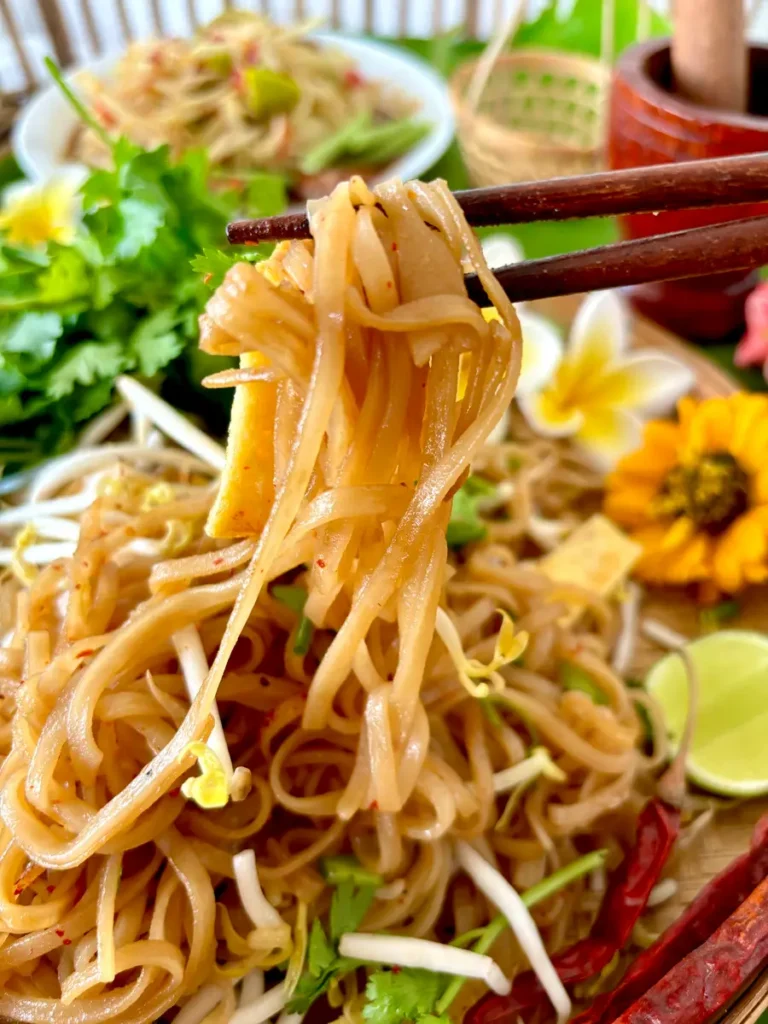
The traditional kua mee recipe (or khua mee) calls for rice noodles, the kind you’d find in pho or pad Thai. You can get them, and all other ingredients you’ll need, at any Asian grocery store or online at Amazon.
Unique to this Lao noodle stir-fry is the addition of egg. Not just scrambled in, but a seasoned omelet sliced into thin, flavorful strips. It gives this Lao dish extra structure and more taste.
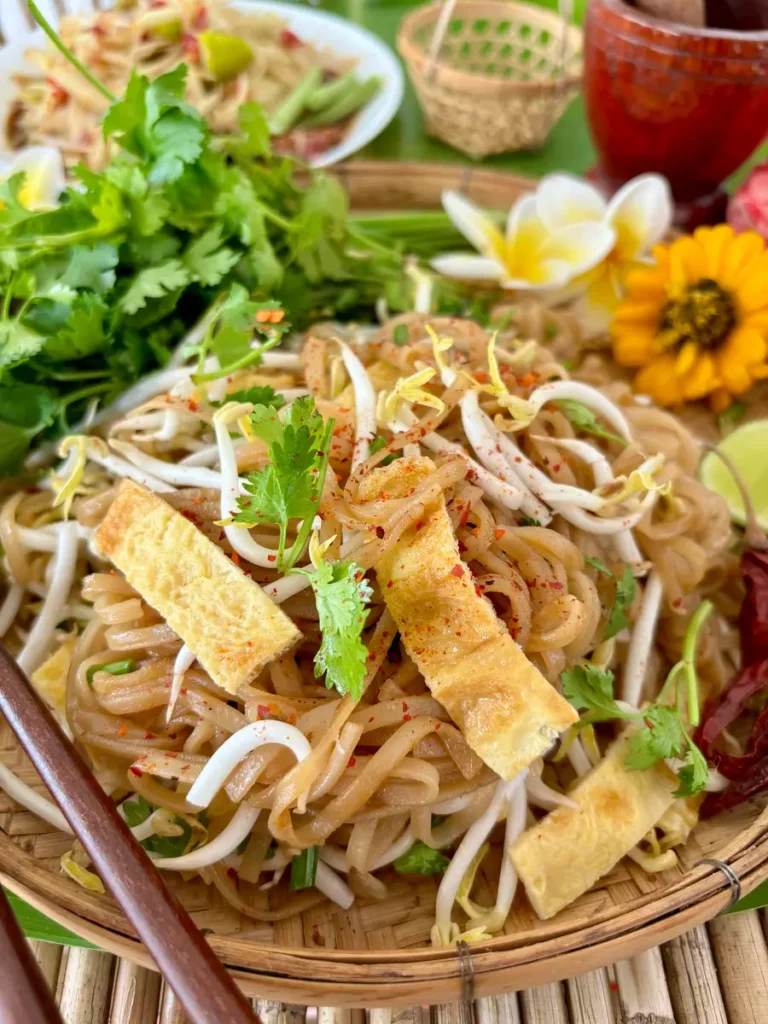
Kua mee vs pad Thai
Kua mee might seem similar to pad Thai, but with its unique method of preparation, pad Lao is a dish like no other.
Pad Thai is:
- Thailand’s famous stir-fried noodle dish.
- Usually prepared with tamarind and sometimes garnished with peanuts.
- Tangy, sweet, and salty flavor profile.
- The noodles are stir-fried in a pad Thai sauce.
Kua mee is:
- Laos’s iconic dry noodle dish.
- The addition of seasoned egg strips is what sets it apart.
- A balance of sweet and salty.
- The noodles are caramelized in sugar, which makes them slightly sweeter.

Why try this pad Lao recipe
- This is authentic Lao food. This is an authentic recipe from Lao cuisine. It’s the signature Lao dry noodle dish.
- It’s perfect for parties. Fun fact: this dish doesn’t have to be served hot. It tastes amazing at room temperature. That’s why it’s perfect for meal prep and your next gathering.
- It has a unique flavor. The caramelized sugar gives the noodles a sweet flavor.
- So quick and easy. You’ll whip this up in less than 30 minutes. It tastes amazing and there’s not too much fuss. The most exciting part is caramelizing the sugar. Once you get the hang of that, the rest is peanuts.
- It’s super tasty. The noodles are slippery, sweet, savory, with tender egg strips. I could have this for breakfast, lunch, or dinner any day!
Can’t get enough of noodle stir-fries? Try my spicy chili garlic noodles or my irresistible beef pad see ew!
Ingredients
Ingredients can be sourced at Asian grocery stores and Asian markets.
The exact measurements are in the recipe card at the end of this post.
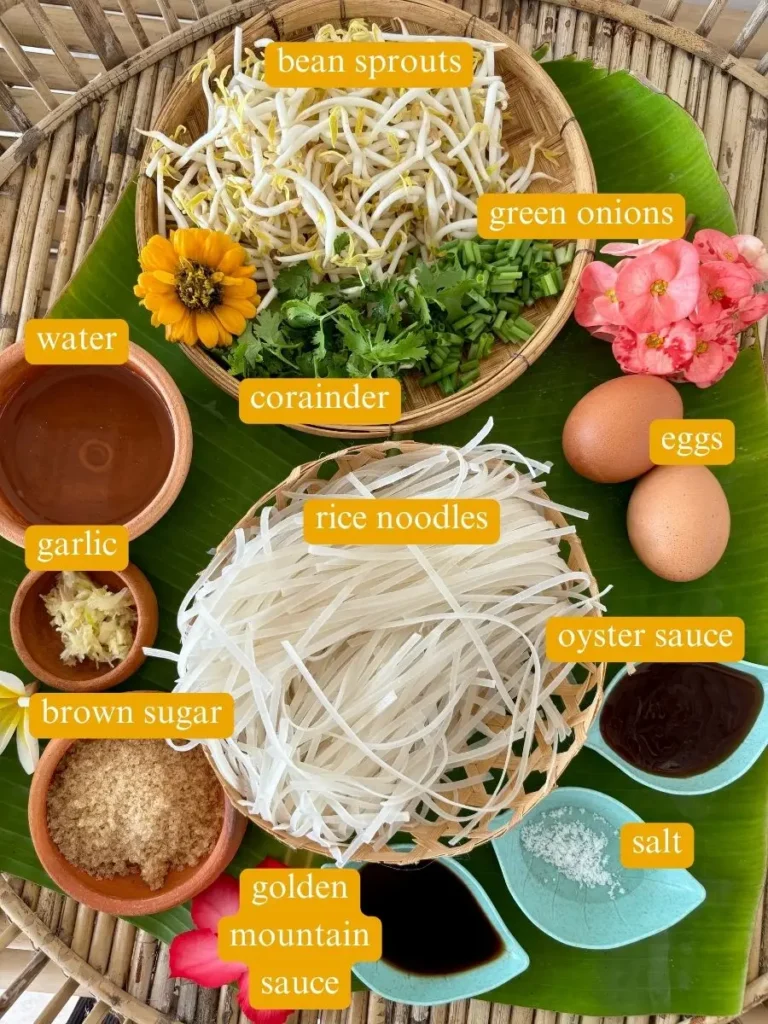
- Noodles – The signature kua mee noodles are rice noodles. Rice noodles are made of rice and wheat flour, a staple in many Southeast Asian noodle dishes. They’re great at absorbing all the sauce and flavors of the caramelization process.
- Bean sprouts, coriander, green onions
- Golden mountain sauce – A flavor enhancer that adds umami and brings out the best in the dish.
- Dark soy sauce (optional) – Adds a dark color to the noodles and a slightly salty flavor.
- Oyster sauce – A staple in many Asian stir-fries, oyster sauce adds a savory flavor.
- Brown sugar – Crucial for the signature caramelization of the noodles, providing the sweet flavor.
- Water
- Dried chilies (optional) – For those who like spicy noodles, dried chilies can be added.
- Oil
For the omelet
- Eggs
- Salt
- Oil
Note: Feel free to experiment with ingredients like fish sauce or light soy sauce. These seasonings with the caramelized noodles are what works for me.
Cooking instructions
1. Soak your noodles in water according to package labeling.
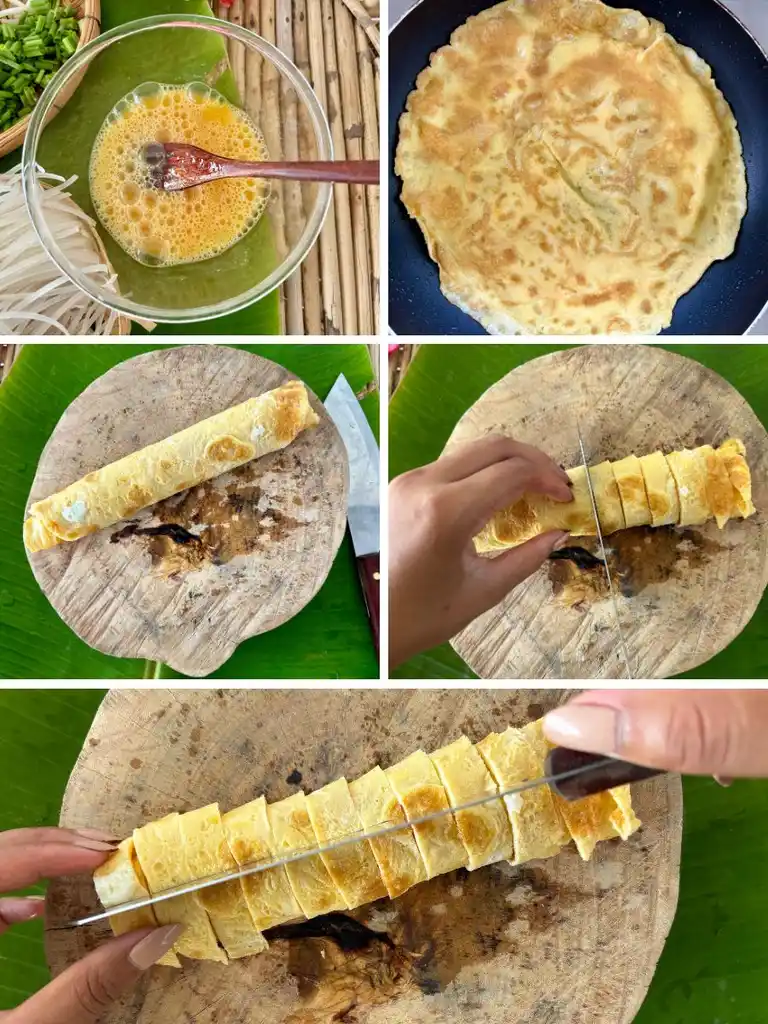
2. Crack the eggs into a mixing bowl, sprinkle in salt, and whisk. Heat up your pan over medium heat and let the egg mixture cook for about 2 minutes, then flip. Once cooked, slice the omelet into thin strips.
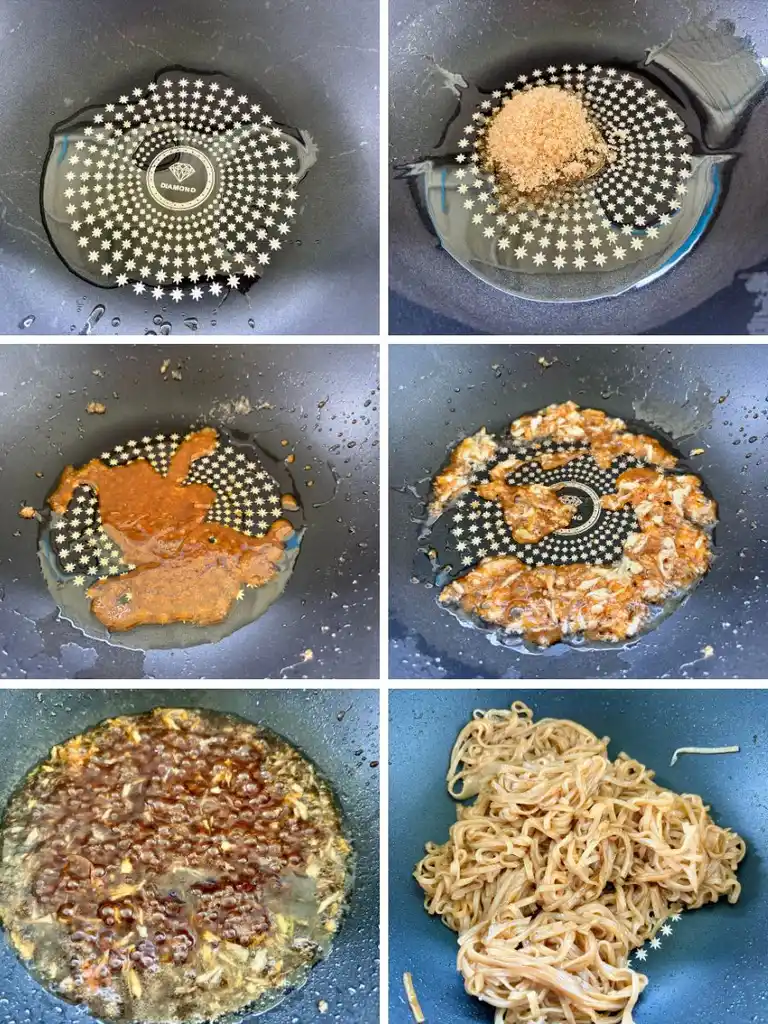
3. Caramelize the sugar by warming oil at medium-low heat and then adding sugar. Cook until it achieves a light golden color.
4. Add garlic and sauté for a brief period until it releases aroma.
5. Cease the caramelization by adding water. Following, add oyster sauce, golden mountain, and the optional dark soy sauce.
6. Stir the mixture thoroughly and allow it to come to a gentle boil.
7. Add the pre-soaked noodles into the wok, stirring until the noodles have absorbed most of the liquid and are cooked al dente.
8. Remove the noodles from the heat and place then in a bowl to cool.
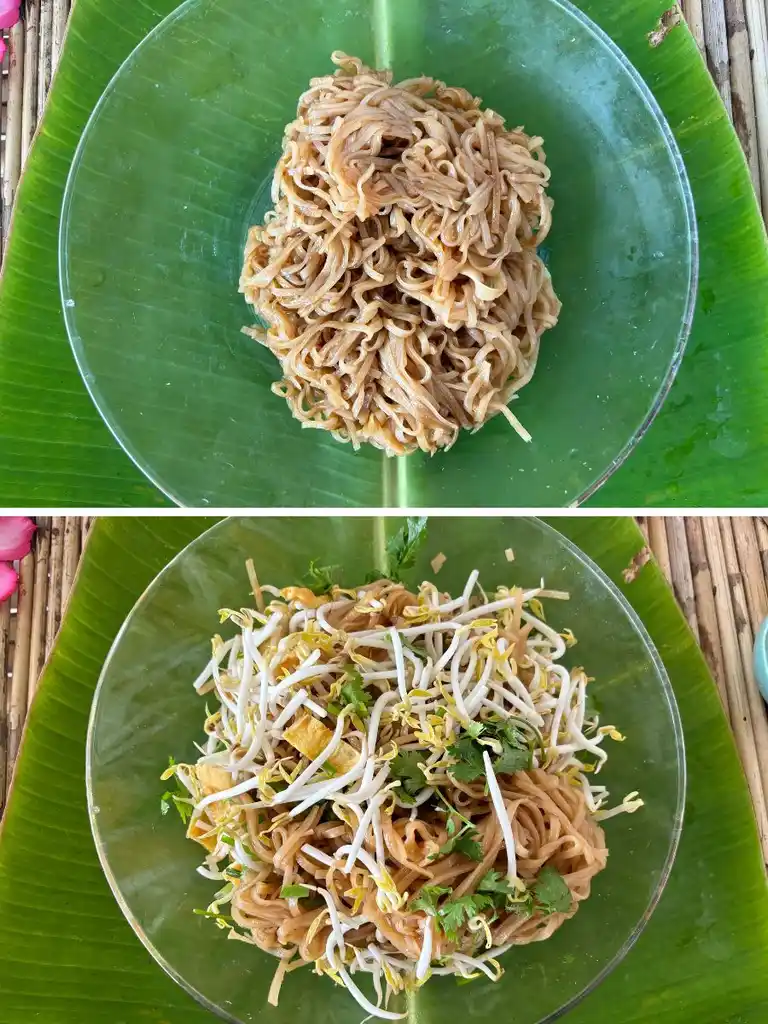
9. Let the noodles rest until cool. Add chopped cilantro, sliced green onions, bean sprouts, and egg strips, combining all ingredients with a gentle toss. Serve immediately.
Tips for the best stir-fried noodles
- Garnish towards the end. Add fresh herbs and bean sprouts towards the end. They have to be crunchy and fresh, in contrast against the soft noodles.
- Prepare the omelet first. Prepare the omelet and cut it into fine strips before beginning with the kua mee recipe.
- Caramelize, don’t burn. You want a golden, caramel hue. If the caramelization process is burnt, don’t continue, but just start over.
- Stir-fry over high heat. Keep the noodles moving and use high heat. This prevents them from sticking to the pan and helps in even cooking.
- Taste-test as you go. Everyone has different taste preferences, so taste-test while cooking and adjust seasonings if needed. The flavors should be salty and sweet.
Kitchen tools
- Non-stick wok or large frying pan
- Cutting board and chef’s knife
- Measuring spoons and cups
- Mixing bowl: For beating the egg.
- Colander: For draining the soaked noodles.
- Spatula
How to serve
After cooking the noodles, spread them out on a large plate or in a shallow bowl. Add bean sprouts, chopped herbs, and the optional dried chilies. Use a mixing glove or tongs to thoroughly mix all ingredients.
Pad Lao is amazing on its own, but even better with a spicy Thai salad like som tum Thai or long bean salad.
Garnishing options
- Crushed peanuts: Although not traditional, you can add some crushed peanuts to resemble that nutty flavor we all love in pad Thai.
- A slice of lime: For those who like to add a sour flavor.
- Thai chili flakes: For a spicy note.
How to store and reheat
Let your kua mee cool down to room temperature and transfer it into an airtight container. Store it in the fridge for up to 3–4 days.
Reheating instructions: Reheat in the microwave or on the stove top over medium heat in a pan or wok, with a splash of water or sauce.
Did you know?
- These sweet noodles, along with other dishes, are laid out buffet style in Laotion gatherings like weddings, festivals, or family activities. Just as in Isan, the Northeast of Thailand, communal eating is a big part of the culture.
- “Kua” means to “stir-fry”, and “mee” means noodles in Laotian.
- Lao kua mee is pronounced as “koo-ah mee”.
Frequently asked questions
What noodles are best for kua mee?
Medium-thickness rice noodles are ideal. They have the perfect texture for stir-frying. Alternatively, you can use thin or wide rice noodles.
Can I make this vegetarian?
Absolutely. Simply use a substitute for oyster sauce, like vegetarian oyster sauce.
Is kua mee spicy?
No, kua mee is not supposed to be spicy. You can adjust the spice level using dried chilies.
Is this recipe gluten-free?
No, dark soy sauce, oyster sauce, and most golden mountain sauces contain gluten. You can use gluten-free versions if available.
More noodle recipes you’ll love
- Rice vermicelli stir-fry
- Yum woon sen pork – A refreshing noodle salad with vegetables.
- Chicken khao soi – A comforting egg noodle dish with coconut milk and curry paste.
- Pad mee korat – A spicier, simplified version of pad Thai.
- Dry tom yum – Dry noodles with tom yum flavor, so good.
If you loved reading this kua mee recipe, please make my day by dropping a star rating and/or a comment below!
Kua Mee Recipe (Pad Lao)
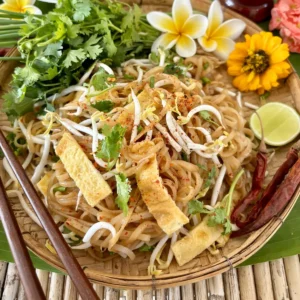
Ingredients
MAIN
- 7 oz dry rice noodles
- 3 oz or 2 cups bean sprouts
- 4 tablespoons brown sugar
- 1/2 teaspoon dark soy sauce
- 1 tablespoon golden mountain sauce
- 2 tablespoons oyster sauce
- 2 tablespoons coriander, chopped
- 2 stalks of green onions, chopped
- 2 cloves of garlic, minced
- 2 tablespoons oil
- 2 cups water
OMELET
- 1 tablespoon oil
- 2 large eggs
- 1/2 teaspoon salt
Instructions
- Soak your noodles in water according to package labeling.
- Crack the eggs into a mixing bowl, sprinkle in salt, and whisk. Heat up your pan over medium heat and let the egg mixture cook for about 2 minutes, then flip. Once cooked, slice the omelet into thin strips.
- Caramelize the sugar by warming oil at medium-low heat and then adding sugar. Cook until it achieves a light golden color.
- Add garlic and sauté for a brief period until it releases aroma.
- Cease the caramelization by adding water. Following, add oyster sauce, golden mountain, and the optional dark soy sauce.
- Stir the mixture thoroughly and allow it to come to a gentle boil.
- Add the pre-soaked noodles into the wok, stirring until the noodles have absorbed most of the liquid and are cooked al dente.
- Remove the noodles from the heat and place then in a bowl to cool.
- Let the noodles rest until cool. Add chopped cilantro, sliced green onions, bean sprouts, and egg strips, combining all ingredients with a gentle toss. Serve immediately.
Notes
- Use the nutrition card in this recipe as a guideline.
- Feel free to add your favorite protein like chicken, shrimp, pork, and beef.

